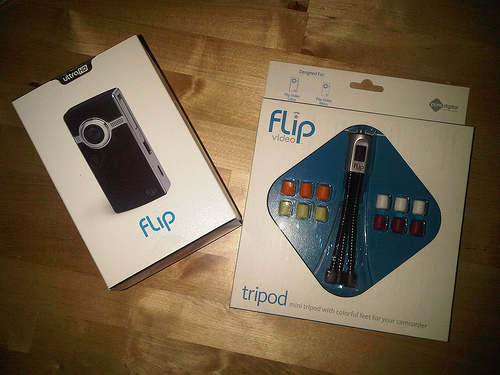I love making videos. Sometimes.
I've had a Sony video camera sitting on my desk ever since my roadtrip from Vancouver to Los Angeles in 2008. I've used it on random occasions to film events, but not much really thereafter.
Recently, I decided to replace this rig (the Sony HDR-HC9, a AC-VQH10 charger, and four massive NP-FH100 “Actiforce” batteries) with a single handheld camera from Flip Video. This camera, called the “UltraHD” cost just $149.99 USD and shoots beautiful 1280x720 (720p HD) video. Unlike my Sony, this camera is actually innovative.

What's missing
Still, there are some features missing on the UltraHD:
- An optical zoom, not a digital zoom. Honestly, I could live without this… but accidently hitting the digital zoom in/out buttons basically ruins your video. Be careful. You can zoom in using video-editing software on the computer for roughly the same effect… maybe even better. An optical zoom would be nice, but even that's not really necessary if you're clever enough.
- An optical image stabilizer. Walking around with the UltraHD produces decent video, but there is considerably more jitter if you're not using some sort of tripod or camera stabilizing equipment. The “locked” position of the image sensor is great for action video footage where you do not want a “rolling shudder” effect (present in many modern consumer camcorders)… but terrible if you do not have a way to stabilize the video whatsoever. Plan accordingly.
- No expandable storage. Again, no big deal here. But if you fill up the UltraHD with no laptop nearby to download everything… be prepared to delete a few clips or continue without recording. Two hours is a lot of recording capacity, but may not be enough in some instances. For everything that this camera does, though… I can't complain. I rarely require more than “two tapes worth” (120min) of capacity, and it's a lot quicker to transfer files to a laptop than to import via DV if you don't have any tapes. However… it's a lot less expensive to carry extra tapes than it is to carry an extra Flip UltraHD unit with you.
What's awesome
The UltraHD does have compelling benefits that outweigh the “cons”:
- No moving parts inside. Less to break, less to maintain, less weight, and less complexity. A tape camcorder or one with a zooming/focusing/adjusting lens is more delicate and intricate.
- Simple and inexpensive, yet professional level. If you can master the lack of an optical image stabilizer, you can shoot extremely clear, professional video with this camera for much less than the cost of a high-level camera.
- Fits in your pocket. Comes with everything you need, as well… including a nice carrying pouch that can be used to clean the camera's lens in just seconds.
- Charges from a USB Port, and can be powered by two AA batteries in a pinch. Self-explanitory. If you have a computer or even an iPod charger, you can charge your Flip. If you don't have either of these things, just stop anywhere and buy two AA batteries. Done!
Editing and sharing the footage
One complaint I had about the way the Flip cameras work is that their H.264 file-format (very common) isn't convenient for use with desktop video-editing software. I generally use Final Cut Pro, and I had to run the files through Compressor for them to import properly.
I suggest converting your source files to “Apple ProRes” format. It is unlikely to reduce quality noticeably via a transcode, and is one of the presets in Compressor if you dig deep enough. (I think it's under “Apple -> Formats -> Quicktime”)
This will make a duplicate of each video-file and it will be ~10x the size of the original, though! But, these files should then work fine with Final Cut Pro, and so you'll just need some extra free disk-space while you're editing. Compressor is also great for gamma correction, deinterlacing (not necessary with the Flip cameras, though, since they're 720p!), and also afterward for exporting your video back to a file that's ready for sharing on YouTube, Vimeo, or other social media.